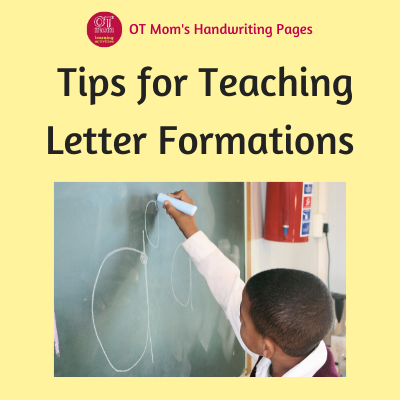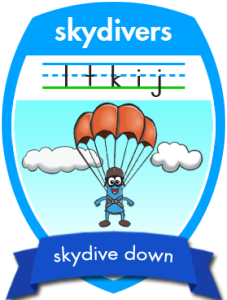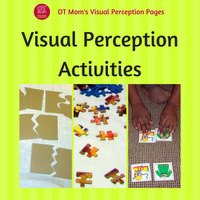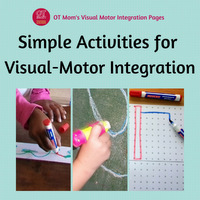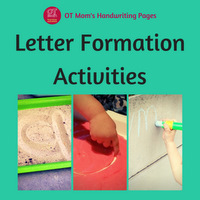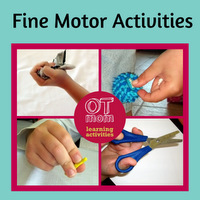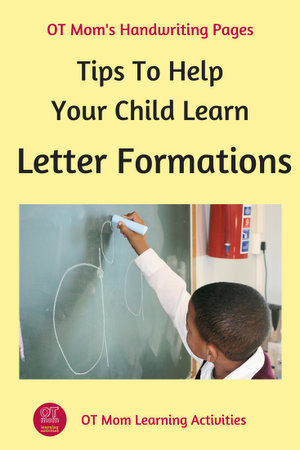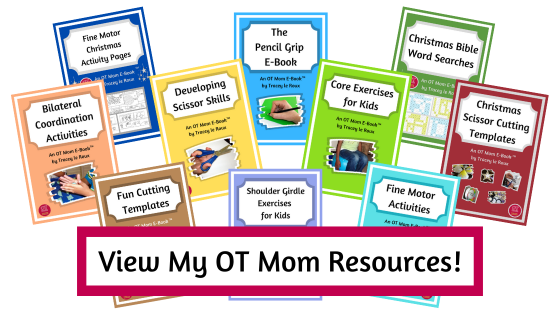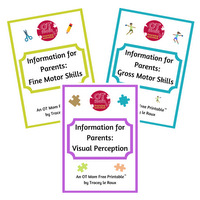- Home Page
- Handwriting for Kids
- Letter Formation Tips
Letter Formation Tips
Strategies for Teaching Kids Effectively
Learning correct letter formation is a vital part of early childhood development, and should start from the moment they want to write their own name. If your child is struggling to write letters and numbers correctly, or if you have no idea how to teach them how to form letters, then these tips and strategies may help.
I sometimes link to products (#Ad) that are similar to those I use and love. If you do purchase something through my links, I will receive a small commission that helps support my site - thank you!
Why Is Letter Formation Important?
Kids who have not learned to form letters consistently correctly may be putting so much effort into remembering and writing the letters that they don't have the mental energy left for creative writing or correctly answering questions.
This is why I feel it is important to teach correct letter formations from the very beginning. Once your child can write letters correctly, automatically, without thinking about them, he/she will be able to focus more on the actual learning process and on writing creatively!
Children should not be expected to “catch” writing skills just from being given opportunities to play with pencil and paper activities – rather, they need to learn to master handwriting with very specific lessons! (Graham, 1999, in Christensen, 2004)
Learning to form letters correctly forms a big part of efficient handwriting.
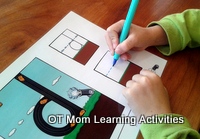 Learning to form letters correctly
Learning to form letters correctlyStrategies To Teach Letter Formation
Children should not be expected to learn how to form letters correctly if they have not mastered some basic underlying skills. If your child has no clue how to copy and form letters correctly, then take a step back and look at some of these strategies that may help.
1) Shapes and Patterns Before Letters and Numbers
If your child has not yet mastered drawing shapes and patterns, then work on these first before attempting numbers and letters.
Tracing and drawing shapes and patterns will help your child master the diagonals and curves necessary for correct letter formations.
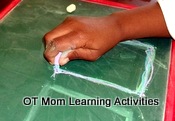 Shapes First!
Shapes First!2) Simple Steps to Mastery: Trace then Copy then Write with Cues
The order of mastery is to first trace the letters, then to copy them, then to write them with a starting point cue, then to write them completely independently without cues.
If your child can not yet copy a letter with the correct formation, then write the letter yourself and have your child trace it.
You may even find it helpful to guide your child’s hand as they trace the letter as shown here.
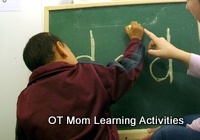 Guiding your child's hand may help.
Guiding your child's hand may help.3) Use Correct Formations The First Time Your Child Writes Their Name!
Kids often want to write their own name long before they are ready to start formal handwriting lessons, and it is often the only "writing" they will do for a year or two.
So use the opportunity to start teaching correct formations with the letters of your child’s name. So often, preschoolers learn to write their name by copying it any old how – and poor letter formation habits become deeply entrenched.
Help your preschooler master the letters of their own name correctly, and you will have laid a good foundation for learning the other letters.
- You can start by having them build their name with playdough, or with magnetic letters on the fridge.
- Write their name one letter at a time and have them trace over the letter with a finger. Guide their hand if you need to.
- Use some of these fun letter formation activities to help them master the letters without using a pencil and paper.
4) Teach Letters in Families
Similarly formed letters should be taught together for maximum impact – for example c, d, o.
When letters are taught in families of similar formations, it is much easier for children to remember and master the correct formations.
Make use of a good handwriting program such as Handwriting Heroes#Ad, which teaches letters in families.
5) Ensure Your Child Starts In The Right Place and Flows Correctly!
Some kids are very good at getting their letter to LOOK correct, but their strokes were perhaps bottom to top, or right to left, which can lead to handwriting issues later.
So, pay careful attention to HOW your child forms the letter, not just what it looks like at the end! If you catch formation errors early, they are much easier to correct!
6) Use a Multisensory Approach
There are some fun ideas on my letter formation activities page, to help your child master letter formations in different ways. These are especially great for kids with poor fine motor skills, as they can still master the correct formation without using a pencil and paper!
Look for stories, animations, rhymes and songs about letter formation, which will help your child remember where to start and stop each letter.
Handwriting Heroes#Ad provides everything you need for a multisensory approach!
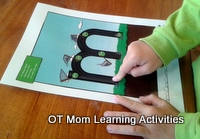 Tracing while saying the rhyme
Tracing while saying the rhymeI used a similar program to help my own kids remember the correct formations when they were young. The stories and rhymes behind each letter helped reinforce learning.
7) Incorporate Letter Formations into Gross Motor Activities
Try making letter formations part of a gross motor activity. For example, have your child crawl, hop or jump to each letter and trace it, whether on a floor, a table or a wall.
This makes it fun and also challenges your child to recall the correct formation even when not sitting at a desk (applying learning in different situations).
Why Do Some Kids Struggle to Learn Letter Formations?
Learning to form letters and numbers correctly involves a number of different foundation skills.
Schickedanz (1999, in Dinehart, 2014) believes that children not only have to
- see the letter correctly reproduced in front of them, but they also need to
- recognize the line segments that form the letter and then
- have the ability to reproduce the sequence and direction of the segments that make up the letter.
Here are some of the foundation skills your child needs in order to master letter formations:
- Good visual perception skills will enable your child be able to perceive the parts of the letter correctly (straight line, curves, diagonals).
- Good fine motor skills will enable your child to hold and control a pencil or crayon in order to replicate the letter efficiently.
- Good visual-motor integration skills will enable your child's visual system to guide the motor system in correctly forming and spacing the letter.
So if your child struggles with any or all of these foundational areas, then he/she may struggle to form letters correctly.
Letter Formation Tips For Kids Who Struggle
If your child is struggling to form recognizable numbers and letters, I really recommend you take a break from working on these, and work on some of the underlying foundational skills that I describe above.
This is particularly true if your child is still in preschool!
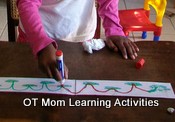 Work on visual-motor integration skills
Work on visual-motor integration skillsThere are lots of free activities on my site to help promote your child’s normal development. Click on the images below to visit different pages on my site and get great activities to help your child!
Get Your OT Mom Free Printable!
If you liked the tips on this page, you can download them for yourself or to hand out to parents!
You will get all the tips on this page in a printable, accessible format.
Fill in this form to access your freebie right away! You also have the option of signing up for my newsletter through this form!
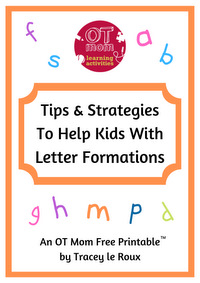 Free Download!
Free Download!I hope you found this page helpful!
Why not sign up for my occasional newsletter to stay in touch with new activities and tips on my site?
- Home Page
- Handwriting for Kids
- Letter Formation Tips
Share this page to help others!
References
Dinehart, L.D. Handwriting in early childhood education: Current research and future implications. Journal of Early Childhood Literacy. March 2014. http://dx.doi.org/10.1177/1468798414522825
Christensen, C.A. Relationship between orthographic-motor integration and computer use of the production of creative and well-structured written text. British Journal of Educational Psychology 74(Pt 4):551-64. December 2004. http://dx.doi.org/10.1348/0007099042376373
Didn't find what you were looking for? Try a search of my site!
